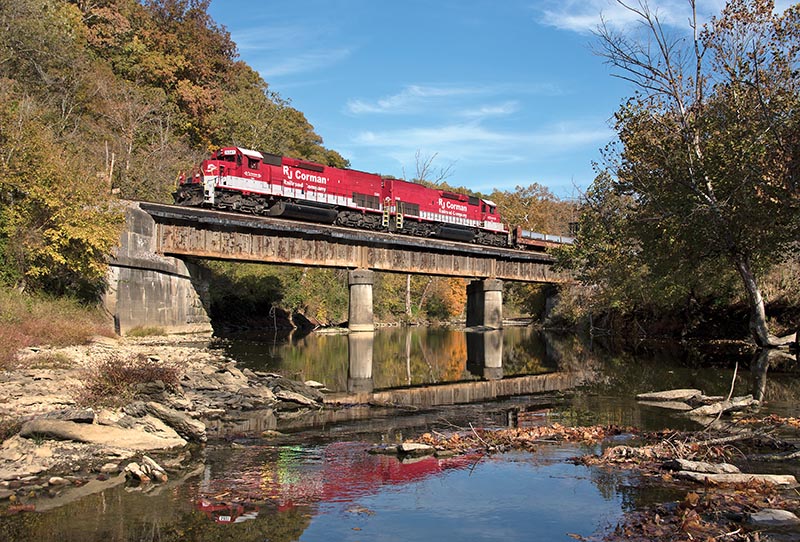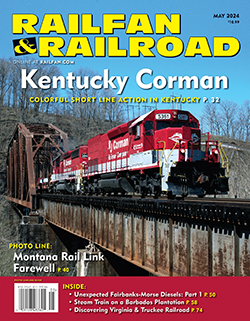 by Garland McKee/photos by the author
by Garland McKee/photos by the author
Richard J. Corman, a native of Nicholasville, Ky., got into the railroad industry right after graduating high school in 1973. Over a span of 40 years, he was able to build his business from a single backhoe working construction jobs into one of the nation’s leading railroad service providers, expanding from railroad construction to derailment and wreck recovery, as well as acquiring short lines and contract switching operations. Today the R.J. Corman company, headquartered in Nicholasville, has divisions in 23 states, employing approximately 1,400 people. Corman passed away in 2013, after a years-long battle with cancer.
Here we’ll look at one small piece of the Corman empire, Central Kentucky Lines (RJCC), located in its namesake state. First acquired by Corman in March 2003 from CSX Transportation, the 148-mile Central Kentucky Lines is in many ways the heart of Corman railroads. The line was the former Louisville & Nashville Old Road Subdivision and includes one of the first railroads built west of the Alleghenies, Lexington & Ohio, which was built in 1833–1834 from Lexington to Frankfort, with an incline to reach downtown Frankfort.
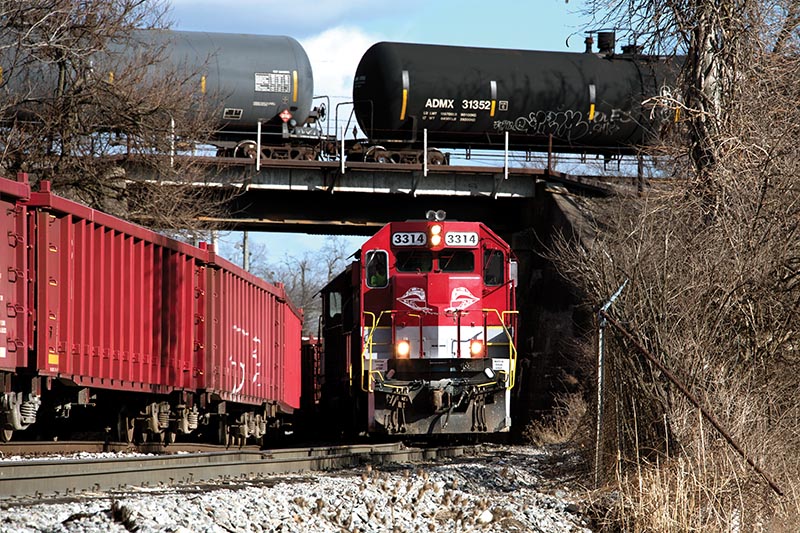
ABOVE: A very common sight — one of the locals works the Lexington Rupp Yard lead while loaded sand cars hold down the main on the left on February 25, 2021. Meanwhile, a Norfolk Southern (Cincinnati, New Orleans & Texas Pacific) train passes overhead. In L&N days, this location was GM Tower, which controlled the west end of the West Lexington yard from a manual interlocking tower on the other side of the overpass.
In 1852, Louisville & Frankfort built its line connecting its namesake cities, completing a line between Louisville and Lexington. Eventually, this would become part of L&N’s Eastern Kentucky Division which extended from La Grange (27 miles east of Louisville) to its end in the eastern Kentucky coal fields at Fleming (east of Whitesburg), totaling 272 miles. L&N would later build a new line between HK Tower in Anchorage, (mile 12.5) and Christiansburg (called Lewis on L&N and now called Wick Moorman on Corman), cutting 11 miles off the distance via La Grange. Still later, the segment between HK Tower and North Cabin in Winchester would become the CSX Old Road Sub.
Hauling Aluminum Ingots
That brings us to the more modern history. As mentioned, Corman purchased the Old Road from CSX in 2003. Coal traffic had dwindled to very little and daily freight was shrinking; the Lexington yard was mostly empty. Corman made two big changes — first, he arranged trackage rights over CSX’s CC Sub from North Cabin in Winchester to Berea and from HK Tower to Louisville. This allowed him to run the “Alcan” train from Berea to Louisville where CSX would take it to Memphis Junction near Bowling Green on CSX’s former L&N Mainline Sub and interchange it with Corman’s Memphis Line (RJCM) that serves Logan Aluminum in Russellville. The Russellville plant is a joint venture between Novelis and Tri-Arrows Aluminum and produces more than one-third of the aluminum cans used in America. The “Alcan” is named for Alcan Aluminum Corporation, the original owner of the aluminum plant in Berea. Naturally, the name has stuck despite the company change.
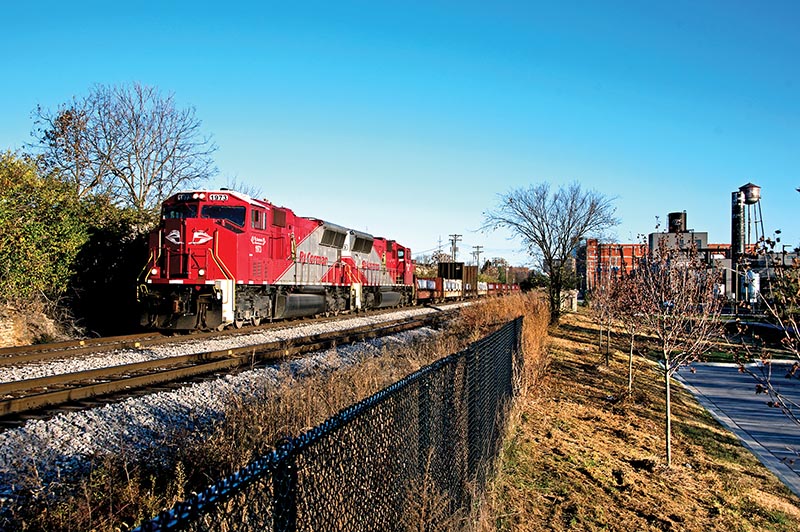
ABOVE: RJC Train Z545 is departing Lexington on November 18, 2023, with the matching units that celebrated Corman’s 50th anniversary in 2023.
Today, the Berea plant is owned by Novelis, which takes about 20 percent of the United States’ used aluminum cans and turns them into aluminum ingots. Corman, which switches the plant, in turn hauls the ingots to Russellville where they are turned into new cans and other products. This brings us to the “Alcan” train (the “Red Rocket,” as it’s sometimes known as on CSX). Every other day, the Alcan leaves Berea with 37–40 loaded cars, each carrying two aluminum ingots, for its roughly 36-hour round trip to Bowling Green (Memphis Junction) where it trades trains with Corman’s Memphis Lines. A Memphis Line job, MR25, handles the train between Memphis Junction and Russellville. Between Louisville and Memphis Junction, the Alcan is handled by CSX crews as B902.
On CSX’s CC Sub, the trains are Z545 (northbound, loads) and Z544 (southbound). On the LCL Sub it’s reversed — Z545 is now southbound, Z544 northbound. The sand trains are Z546 in both directions (more on them shortly) and the local to Shelbyville is Z543. The Old Road is a north-south railroad for operating purposes. While Corman originally had its own symbols for the Alcan on its railroad, they pretty much fell by the wayside as everyone knew and knows them as Z544 and Z545, or just “the Alcan” for short.
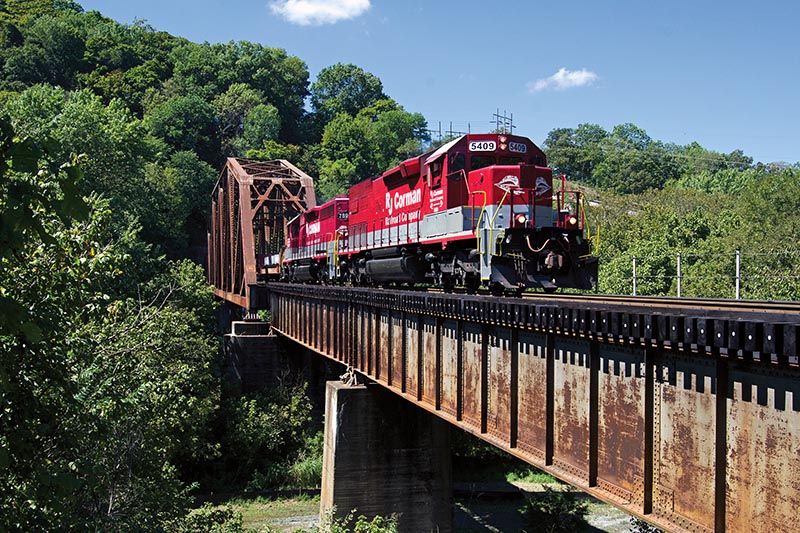
ABOVE: R.J. Corman’s “Alcan,” Train Z545, crosses the Kentucky River at Ford on CSX trackage on September 3, 2016. Starting in early 2023, the older six-axle EMDs were replaced with newer ex-NS SD70Ms.
Sand for Profit
The second big change Corman brought to the Old Road was sand. Not a big moneymaker, most Class I railroads won’t touch it, as it’s too short of a haul and too low of a profit. But with enough of it, a savvy short line can make it profitable (just ask Arkansas & Missouri). Corman hauls sand from Louisville to Lexington in 30-car trains using gondolas several times a week, mostly at night. These run as Z546 over the LCL Sub. In Lexington, a portion of the yard is used for transloading the sand into trucks, which then take the sand to its destinations.
In addition to the Old Road, Corman purchased the 15-mile Lexington & Ohio (LXOH) in 2003 from Gulf & Ohio, which had operated it since 1996. This was part of the former Southern’s Lawrenceburg to Lexington LL Branch. After its purchase, Corman restored the long-gone connection from LXOH to its Rupp Yard in Lexington. It now operates from Lexington to Lawrenceburg where it connects with the Bluegrass Railroad Museum…


